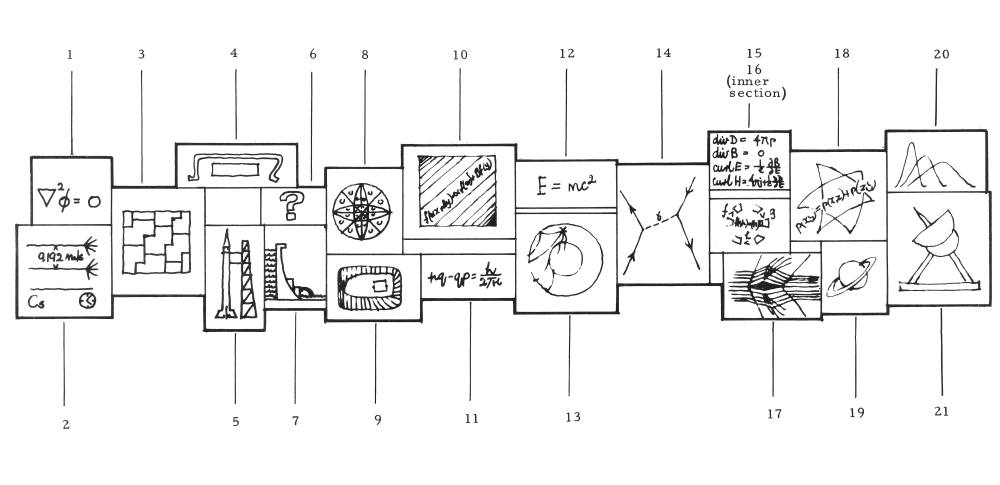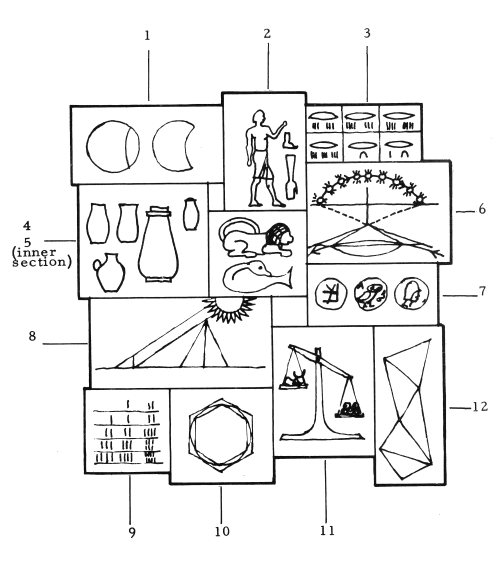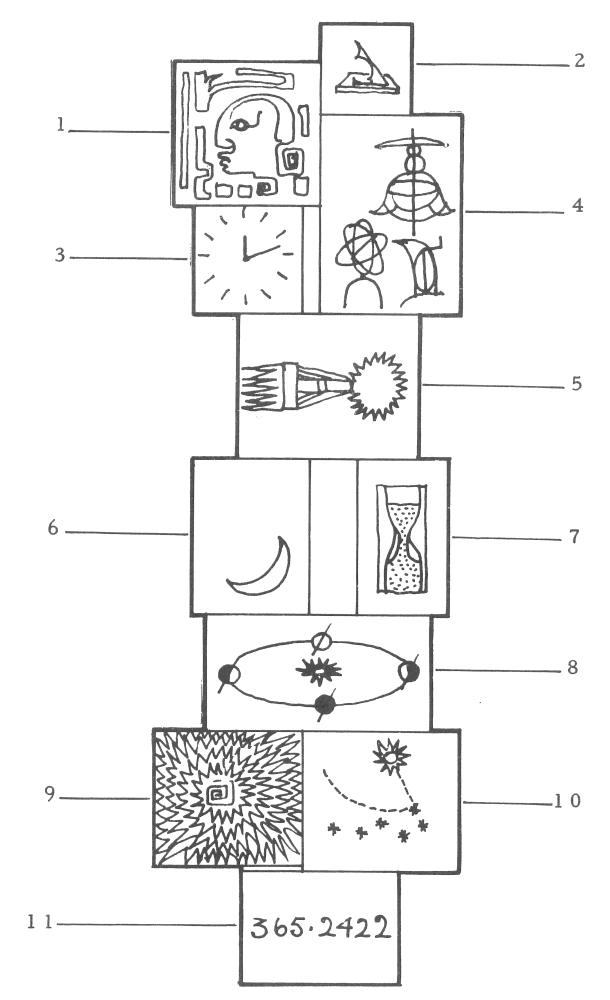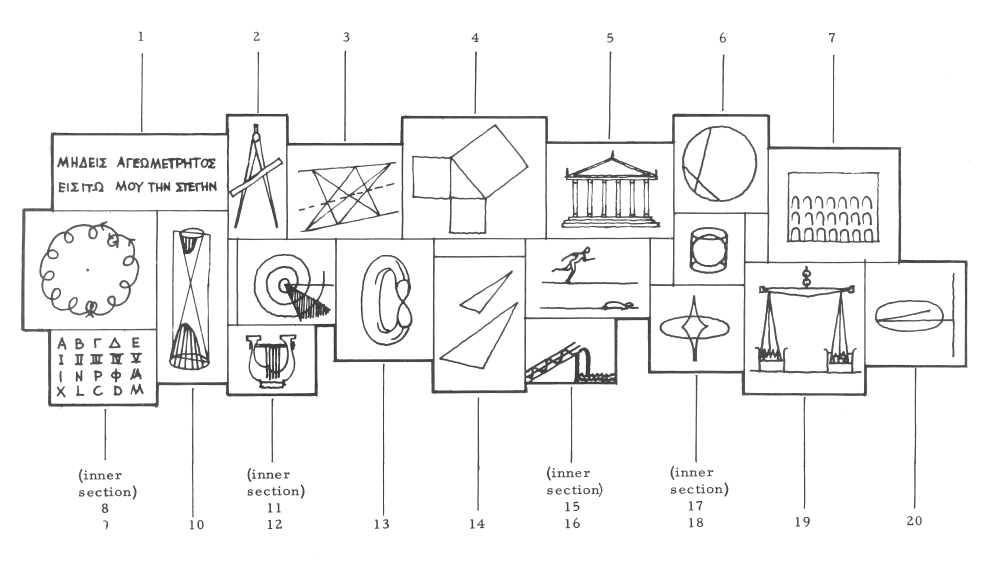- A 1. Laplace's equation:
- This equation arises in many branches of mathematical physics and analytical engineering, and the study of its solutions has led to considerable advances in both pure and applied mathematics.
- A 2. The atomic clock:
- This clock, which depends on the constancy of a special property of the caesium atom, is a modern device for measuring time to very great accuracy.
- A 3. Unsolved problems:
-
The problems studied by the mathematicians of the 19th century and earlier have not by any means all received solutions. The sketch here refers to the map-colouring problem, one of the celebrated unsolved problems of mathematics: - if an arbitrary map on a sphere is to be coloured in such a way that adjacent “countries” are to be of different colours, what is the minimum number of colours required? It is known that four colours are necessary for certain maps, and it has been conjectured that four are sufficient for all maps, but so far this conjecture remains unproved. Curiously, the corresponding problem for maps on the torus (or anchor-ring) has been solved, seven colours in this case being both necessary and sufficient. This sketch illustrates a map on a torus which requires seven colours (or textures), the torus here having been cut and flattened out.
Note: This problem, also known as the four-colour problem, was solved by
Kenneth Appel and Wolfgang Haken in 1976. A number of other famous old problems
of mathematics have been resolved in fairly recent years, such as
Fermat's Last Theorem by Wiles in 1993
and the Poincaré Conjecture by
Perelman in 2003. An example of a problem that remains unsolved is
Goldbach's Conjecture: Every integer greater than 5 can be written as the sum
of three primes.
- A 4. Punched cards and paper tape for electronic computers:
- This section illustrates the punched cards and punched tape which are used in modern electronic computers. These computers do arithmetic at very high speed and can be used to solve many of the mathematical problems of pure and applied science.
Note: In 1961, when the panel was unveiled, the computer revolution was just
beginning. Computers in those days were large machines that
received their instructions via the punched
cards or tape shown on the panel. The incredible speed with which computing
power has increased ever since means that today every mobile phone contains
computing equipment vastly more powerful than these early machines.
- A 5. Rocket at its launching station:
- The giant rockets of the 20th century make possible the exploration of outer space. The design of these rockets, the calculation of their trajectories, and the interpretation of the observations obtained by scientific instruments in the rockets, all involve a very considerable use of mathematics.
Note: In 1961, the opening year of the Mathematics and Oceanography Building,
Yuri Gagarin became the first person to enter space. Eight years later,
Neil Armstrong was first to step on the moon.
- A 6. The Future:
- Many problems of pure and applied mathematics confront us now, and it is more than probable that many more such problems await us beyond the foreseeable future. The use of mathematics in science, engineering and technology is only in its infancy and there is no doubt that many new developments will arise with the growing use of mathematics in these fields.
Note: As is to be expected,
the years since the opening of the building have seen vast developments
in all areas of mathematics. Whole new
areas of pure mathematics have emerged, and applications of mathematics
are important for all sciences.
- A 7. Electric power:
- This illustration, which shows a dam and a pylon, refers to the ever-growing use of electric power. The design of dams, of electricity generating and distribution systems, and of electric and electronic devices, involves the use of many different branches of mathematics.
- A 8. Algebraic topology:
- This subject is essentially a product of the 20th century, and the considerable advances which have been made in it have had far-reaching consequences in many branches of geometry. The sketch shows an example of the triangulation of a surface, a concept which played an important part in the early development of the subject.
- A 9. Differential geometry:
The Möbius strip:
-
The Möbius strips is an example of a non-orientable (one-sided) surface. It is also a simple example of a fibre-bundle, a structure which arose in the study of differential geometry and which has played an important role in the development of many branches of modern mathematics.
- A 10. Linearity:
- The property of linearity represented in this sketch has, during the last 50 years, played an increasingly important part in many branches of algebra, geometry and analysis.
- A 11. Heisenberg commutation equation connecting co-ordinate and momentum:
-
This equation is of fundamental importance in quantum theory: it is a consequence of Heisenberg's Uncertainty Principle, which imposes a limit on the degree of accuracy to which the position and momentum of a particle may be simultaneously measured. The equation reflects a radical departure from classical mechanics, according to which both the position and momentum of a particle are capable of exact simultaneous determination.
- A 12. Einstein equation for the equivalence of mass and energy:
- This equation was deduced by Einstein from his Special Theory of Relativity, and has been confirmed experimentally. The principle which it embodies, that mass and energy are equivalent, is of central importance in present-day concepts of mathematical physics, and has also dramatic practical consequences in the field of nuclear physics.
- A 13. Earthquake waves:
- Earthquake shocks travel through the earth in the form of waves and the irregular paths taken by these waves can be analysed to provide detailed information about the internal structure of the earth.
- A 14. Scattering of an electron by a positron:
- This sketch is typical of a class of diagrams, due to Feynman, which are used to represent processes in physics involving the scattering or transmutation of elementary particles.
- A 15. Maxwell's electromagnetic equations:
- These equations are of fundamental importance in the theory of electromagnetic phenomena, and have numerous scientific and industrial applications. They provide, for example, the mathematical theory for the transmission of radio waves and also that for the generation of magnetic fields by the passage of electric currents in wires.
- A 16. Mappings:
- A mapping from one set to another is a straight-forward generalization of the idea of a function. The theory of abstract groups arose from the study of groups of mappings of a set onto itself under a particular form of multiplication, and the sketch symbolises this multiplication of mappings.
- A 17. Shock waves and the motion of fluids:
- The sketch shows the formation of shock waves when a body with sharp leading and trailing edges passes through a fluid at supersonic speed. Our understanding of the motion of fluids has been considerably sharpened by a combination of mathematics and experimental observations.
- A 18. The triangle inequality:
- The relation which appears in this sketch is known as “the triangle inequality”: if ρ(x, y) denotes the distance from x to y, then the relation expresses the fact that the direct distance from x to y is less than or equal to the distance from x to y via any third point z. This relation, together with two other relations of a somewhat similar character, is used to define a generalized “distance” which includes Euclidean distance as a particular case. Such generalizations of Euclidean distance occur in many situations in pure mathematics, and all these instances can be dealt with by a single theory which examines properties of a “distance” defined axiomatically by the three relations mentioned. Such a use of an axiomatic definition of a general concept to include a large number of special cases is one of the most characteristic features of modern pure mathematics.
- A 19. Astronomy:
- The sketch refers to our greatly increased understanding of distant heavenly bodies. The development of the theories on which our understanding is based, and the cross-linking of observation with theory, depend to a very great extent on the use of mathematics. For example, our understanding of the mechanism of Saturn's rings depends largely on a synthesis of mathematical and observational arguments.
- A 20. Mathematical statistics:
- The sketch shows three normal distribution curves with different centre and spreads. Such curves are commonly used to describe the variations observed in experimental data. Some of the distributions of measurements which they describe may also be predicted on theoretical grounds. The growth of the use of statistical ideas in many branches of science, engineering, and business administration has been one of the remarkable features of 20th century applied mathematics.
- A 21. Radio telescopes:
- These constitute the most important recent addition to the equipment of astronomers. The observations which are being made with them are opening up new avenues of thought concerning the nature of the universe.





